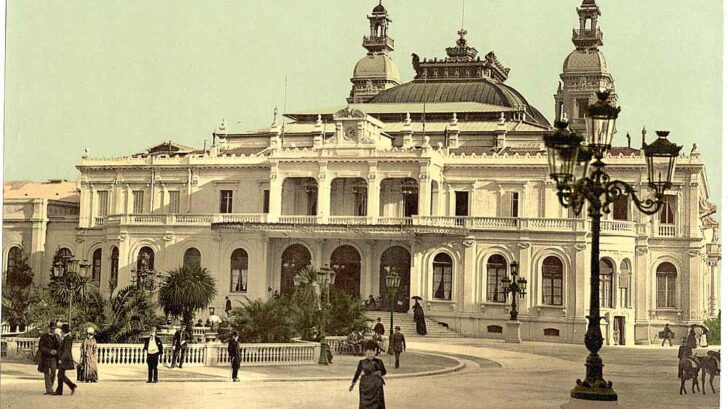Charles Wells: The Man Who Broke the Bank

Charles Wells: The Man Who Broke the Bank in Monte Carlo
Throughout the history of the casino game of roulette, there have been some serious contenders for making profits. The likes of Billy Walters, Joseph Jagger and Ashely Revell are among the most famous and most profitable players ever to have played. Though all these players are interesting and have a story worth telling, no tale can touch that of a certain Charles Wells.
Who Was Charles Wells?
He was an Englishman, born in Hertfordshire in 1841. When he was a wee baby, his parents moved to Marseilles in France, which is where he schooled and grew up. Upon leaving full time education he was to find work as an engineer at the shipyards in Marseilles. Bright and restless, a few years later he came up with a novel device that could regulate the ships propeller. After both developing and then patenting the device, he was able to sell the patent for the princely sum of 5,000 franc ($25,000 in today’s money). And it’s at this point,he realized that working for a living was a mugs game.
So Begins The Fraudsters Life
Armed with these savings, he set out to defraud as many people as possible in the shortest possible time. His first major recorded fraud took place in 1879. He was promoting a railway between Berk Sur Mer in the North of France. Such was his acumen and charm, he was able to find backers from many sources. In truth, we can’t know if he started out with the idea of conning people. But it all ended in fraud, as he ran away with the investors cash. He was to be later convicted in absentia in a French Court.
Read more on JackpotFinder:
Having now learned the ropes, Charles traveled across La Mache to fair Albion, where he took up his new found skills to fabulous results. For example, he devised a musical jump rope, which took in thousands of investment dollars. In fact he had any number of new and exciting inventions and certainly had the gift of the gab to convince the foolish and the ignorant they would become rich by taking part in the development of these schemes. One investor lost £19,000 (£2.4 million today) of the back of one of Well’s great ideas.
Wells Became One of the Biggest Roulette Winners of All Time
As a fraudster, Charles Wells was doing very well for himself, thank you very much. He had by now amasses a small fortune from hoodwinking investors. So it’s not surprising that he wanted to enjoy his good fortune. In August of 1891, he took was was to be the first of a number of trips to Monte Carlo. Starting with a bank roll of 4,000 francs ($20,000) he choose roulette as his poison. Within days he had increased this amount and managed to “break the bank” on multiple occasions. Breaking the bank refers to a games table losing all it’s chips. The casino officials then cover the table with a black cloth until more funds can be secured. Charles Wells left France with a staggering 1 million franc ($5 million) in his portmanteau. He had shown everyone how to win the jackpot.
Fame Bekons
In November of the same year, he re-visited Monte Carlo. And once again he was able to take the casino to the cleaners. He broke the bank on multiple occasions and returned to Albion over 1 million francs richer. Not only had he become fabulously wealthy thanks to his casino exploits, but, more importantly for his ego, he was rapidly becoming famous. It’s was, and still is, very rare for a punter to have such good fortune at the games tale. And consider that he performed this feat twice in a single year. Newspapers and reporters came knocking at his door. Everyone wanted to know his secret.
Of course, Charlie, being Charlie, he had to spin a tale. He claimed that he had, in fact, devised a diabolical scheme that was foolproof and thus enabled him to win such huge amounts. But whatever his real method, it remains unknown even to this day, as Wells absolutely refused to divulge any more details.
The Man Who Broke the Bank at Monte Carlo
It wasn’t long before the public fascination led to Fred Gilbert to compose the song “The man who broke the bank in Monte Carlo”. The song came out in 1892, and proved to be very popular. It fame was spread by the music hall performer, Charles Coborn who took the tune on his world-wide musical comedy show. Though Wells was not the first punter to break the bank in Monte Carlo, with Joseph Jagger having pulled off the same feat in 1873, it’s generally accepted that the song is about Charles Wells as the timing of it’s writing coincided with Charles wins.

Wells Loses Everything and Gets Arrested
We all know that in gambling, one should always quit when ahead. Unfortunately very few gamblers ever heed this advice, and Charles was no different. Not only did he fail to heed this advice, but decided to outdo himself by purchasing a huge yacht, The Tycho Brahe, which he renamed, Palias Royal. He converted the yacht into a huge palace, with a ballroom for fifty guests. Then in January of 1892, he took off once more to Monte Carlo for the third time. But on this trip he was to lose a hefty 100,000 francs. In fact he was to never repeat the magnitude of previous wins. He did claim to have won £2,500 in a visit in 1910. But, then again, he was always full of outlandish claims.
After leaving Monaco, the yacht docked at Le Havre. Finally his previous frauds and scams had caught up with him. He was arrested on board and charged. He was then extradited to England. There he stood trial at the Old Bailey facing 23 counts of fraud. It took but minutes for the jury to find the defendant guilty and the presiding judge sent Wells down for 8 years to be served at Portland Prison.
Charles Wells Initiated a Huge Ponzi Scheme
Based on good behavior, Wells was released early, having served a total of six of his eight year sentence. Within months he was up to his old tricks, but this time playing for very big numbers. He devised an alias f “Lucien Rivier” and moved to Paris. There he found a premises in the nicest part of town. He then opened a bank which offered a return of 365% over the year or 1% per day. He took in over 6,000 investors who clamored to take advantage of this bonanza. But not all was what it seemed to be.

All in all, he collected around 2 million francs ($10 million today). He satisfied the early customers by paying them, not from any profits, as there were none to be had, but using the cash generated by newer investors. And because the initial investors could show proof of their returns, the money flow quickly became a deluge. Though the name “Ponzi Scheme” didn’t make it’s way into the everyday lexicon until a certain Charles Ponzi made the term famous in 1920, Wells was conducting business in the same manner. Separated by a decade, the only difference between the two scams was the amount of return offered. Ponzi was a touch more generous, offering an annual return of 400% as proposed to Well’s offering 365%.
Wells and Rivier Are The Same Person
It wasn’t long before the detective arm of the Gendarmerie, la Sûreté Nationale started to take an interest. Realizing the gig would soon be up, Charles Wells hot tailed it off to Blighty, in the process taking up to 2 million francs to keep him warm at night. Eventually the police put two and two together and realized that Charles Wells and Lucien Rivier were but one and the same person. In England he was once again arrested in January 1912. For the bank fraud, he was sent down for five years. His setting up and subsequent running into the ground of a bank, caused the French Government to change their rules on the vetting procedures necessary for bank ownership.
He left prison penniless. There has been much speculation as to both when and where he died, though most sources settle on the year of 1922. We do know that he is buried in North Sheen Cemetery. For a while he was certainly famous, with both newspapers and even the House of Commons referring to him as “Monte Carlo Wells”. In 1935, a rather tepid movie with the songs title was produced, starring Ronald Coleman. More recently, in Ridley Scott’s “Alien Covenant”, the android David sings the words in mimicking his idol, Lawrence of Arabia.
How Did Wells Actually Beat Roulette?
Here’s the rub: no one knows how he did it. It was, by any standards an extraordinary feat to break the bank twice on successive visits. Essentially there are three main theories;
- He was using the common Martingale system.
- Wells cheating like he had at so many other things in life.
- He got extremely lucky on the first two trips.
No one wants to believe that he created an infallible system. This is because his subsequent visits to the roulette table did not produce the same results. Could he of been using wheel bias? Yes, it’s a long shot. That’s because you would need to play an awful lot at the same wheel in order to notice the tiny differences in results. As he played, and as he won, you can be certain that the casino would of been watching him like a hawk. So that tends to rule out any blatant cheating.
The Only Possible Answer
So that leaves us with the only possible answer. In short he was using the Martingale system as one of his jackpot winning strategies. Doubling up on his loses and halving his gains. Maybe he started with a large enough bankroll to keep going into the millions of francs. If he parlayed his original 400,000 francs into over 1 million, this would represent a 250 x bank roll increase. But if there were no table limits on betting, then, yes, it’s quite possible to achieve these numbers.
Play Slots Online at the King Billy Casino
















